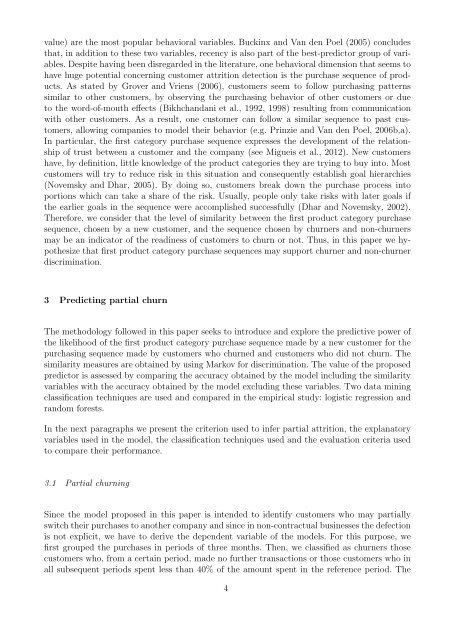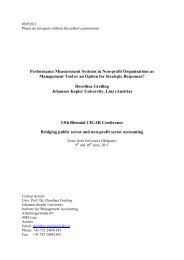Predicting Partial Customer Churn Using Markov for Discrimination ...
Predicting Partial Customer Churn Using Markov for Discrimination ...
Predicting Partial Customer Churn Using Markov for Discrimination ...
You also want an ePaper? Increase the reach of your titles
YUMPU automatically turns print PDFs into web optimized ePapers that Google loves.
value) are the most popular behavioral variables. Buckinx and Van den Poel (2005) concludes<br />
that, in addition to these two variables, recency is also part of the best-predictor group of variables.<br />
Despite having been disregarded in the literature, one behavioral dimension that seems to<br />
have huge potential concerning customer attrition detection is the purchase sequence of products.<br />
As stated by Grover and Vriens (2006), customers seem to follow purchasing patterns<br />
similar to other customers, by observing the purchasing behavior of other customers or due<br />
to the word-of-mouth effects (Bikhchandani et al., 1992, 1998) resulting from communication<br />
with other customers. As a result, one customer can follow a similar sequence to past customers,<br />
allowing companies to model their behavior (e.g. Prinzie and Van den Poel, 2006b,a).<br />
In particular, the first category purchase sequence expresses the development of the relationship<br />
of trust between a customer and the company (see Migueis et al., 2012). New customers<br />
have, by definition, little knowledge of the product categories they are trying to buy into. Most<br />
customers will try to reduce risk in this situation and consequently establish goal hierarchies<br />
(Novemsky and Dhar, 2005). By doing so, customers break down the purchase process into<br />
portions which can take a share of the risk. Usually, people only take risks with later goals if<br />
the earlier goals in the sequence were accomplished successfully (Dhar and Novemsky, 2002).<br />
There<strong>for</strong>e, we consider that the level of similarity between the first product category purchase<br />
sequence, chosen by a new customer, and the sequence chosen by churners and non-churners<br />
may be an indicator of the readiness of customers to churn or not. Thus, in this paper we hypothesize<br />
that first product category purchase sequences may support churner and non-churner<br />
discrimination.<br />
3 <strong>Predicting</strong> partial churn<br />
The methodology followed in this paper seeks to introduce and explore the predictive power of<br />
the likelihood of the first product category purchase sequence made by a new customer <strong>for</strong> the<br />
purchasing sequence made by customers who churned and customers who did not churn. The<br />
similarity measures are obtained by using <strong>Markov</strong> <strong>for</strong> discrimination. The value of the proposed<br />
predictor is assessed by comparing the accuracy obtained by the model including the similarity<br />
variables with the accuracy obtained by the model excluding these variables. Two data mining<br />
classification techniques are used and compared in the empirical study: logistic regression and<br />
random <strong>for</strong>ests.<br />
In the next paragraphs we present the criterion used to infer partial attrition, the explanatory<br />
variables used in the model, the classification techniques used and the evaluation criteria used<br />
to compare their per<strong>for</strong>mance.<br />
3.1 <strong>Partial</strong> churning<br />
Since the model proposed in this paper is intended to identify customers who may partially<br />
switch their purchases to another company and since in non-contractual businesses the defection<br />
is not explicit, we have to derive the dependent variable of the models. For this purpose, we<br />
first grouped the purchases in periods of three months. Then, we classified as churners those<br />
customers who, from a certain period, made no further transactions or those customers who in<br />
all subsequent periods spent less than 40% of the amount spent in the reference period. The<br />
4
















